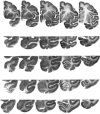Interaction of perirhinal cortex with the fornix-fimbria: memory for objects and "object-in-place" memory
- PMID: 8795638
- PMCID: PMC6578970
- DOI: 10.1523/JNEUROSCI.16-18-05864.1996
Interaction of perirhinal cortex with the fornix-fimbria: memory for objects and "object-in-place" memory
Abstract
Four monkeys (Macaca mulatta) were trained preoperatively in an automated object-in-place memory task in which they learned 20 new scenes in each daily session. In the object-in-place memory task, the correct, rewarded response in each scene is to a particular object of a pair, which always occupies a particular position in a unique background that has been generated using randomly chosen colors and shapes. Each animal then underwent two surgeries, with a period of testing after each. In the first, control surgery, each animal had either a unilateral lesion of the perirhinal cortex or unilateral fornixfimbria transection, combined with section of the body and splenium of the corpus callosum and the anterior commissure (to prevent interhemispheric transfer of visual information). The disconnection was completed in the second surgery, after which all animals had a unilateral perirhinal cortex ablation in one hemisphere, unilateral fornix-fimbria transection in the contralateral hemisphere, and partial forebrain commissurotomy. The monkeys performance was compared for the learning of 200 scenes, preoperatively and after each surgery. After control surgery, the animals were mildly impaired on the object-in-place task. After disconnection, the animals showed a severe impairment in object-in-place memory. We conclude from this that, in episodic memory, the perirhinal cortex provides input of visual object information to the subiculum, hippocampus, and fornix.
Figures



References
-
- Amaral DG, Instausi R. Hippocampal formation. In: Paxinos G, editor. The human nervous system. Academic; London: 1990. pp. 711–755.
-
- Brown MW, Wilson FAW, Riches IP. Neuronal evidence that inferomedial temporal cortex is more important than hippocampus in certain processes underlying recognition memory. Brain Res. 1987;409:158–162. - PubMed
-
- Delay J, Brion S. Masson; Paris: 1969. Le syndrome de Korsakoff. .
-
- Eacott MJ, Gaffan D, Murray EA. Preserved recognition memory for small sets, and impaired stimulus identification for large sets, following rhinal cortex ablation in monkeys. Eur J Neurosci. 1994;6:1466–1478. - PubMed
-
- Gaffan D. The role of the hippocampus-fornix-mammillary system in episodic memory. In: Squire LR, Butters N, editors. Neuropsychology of memory, 2nd Ed. Guilford; New York: 1992. pp. 336–346.
Publication types
MeSH terms
LinkOut - more resources
Full Text Sources
